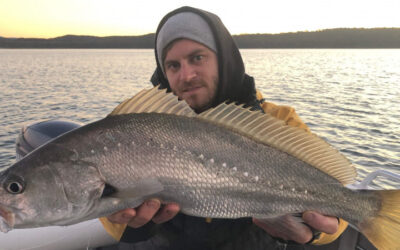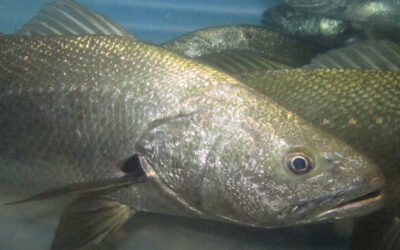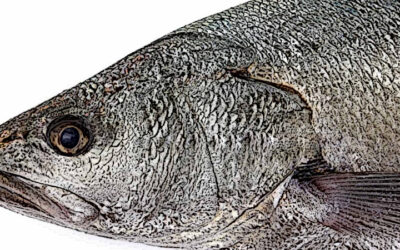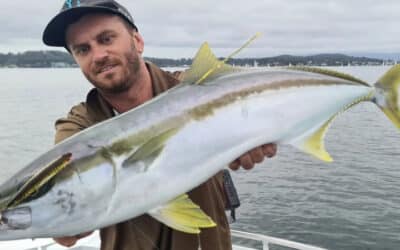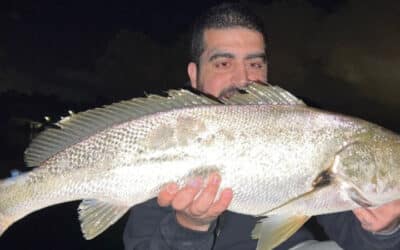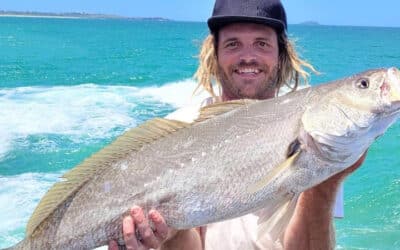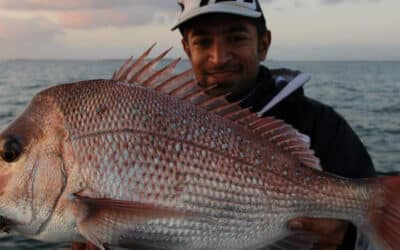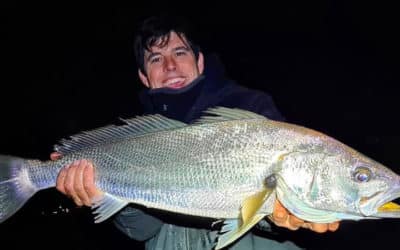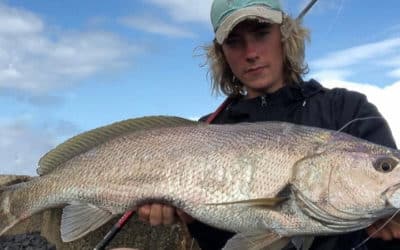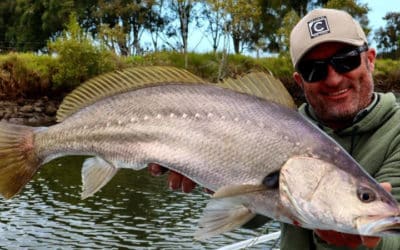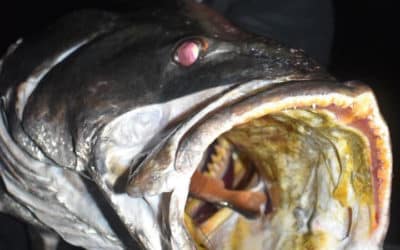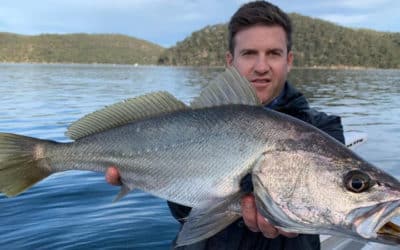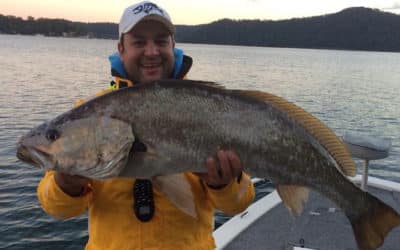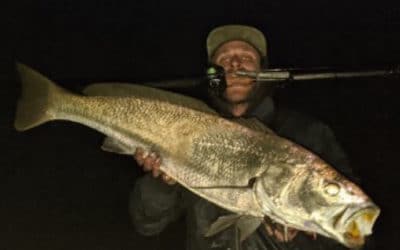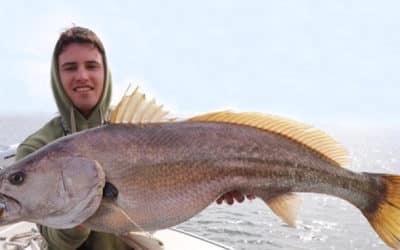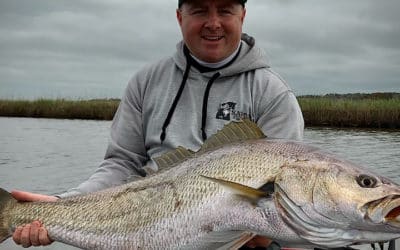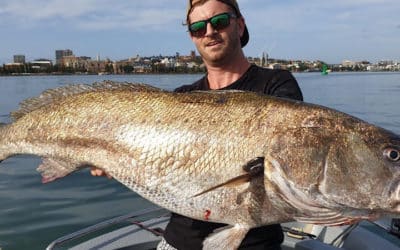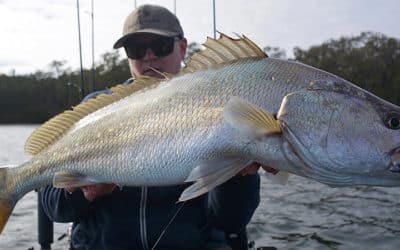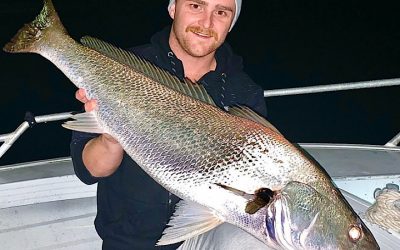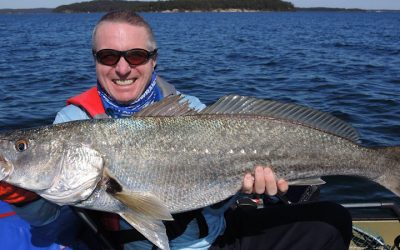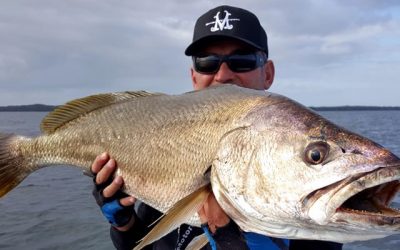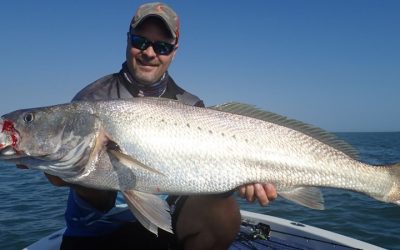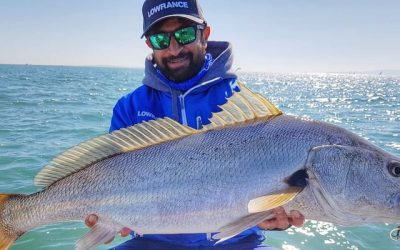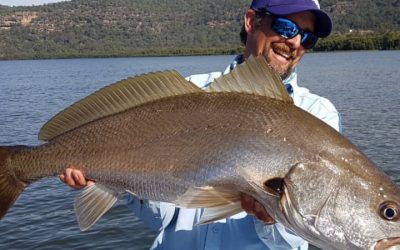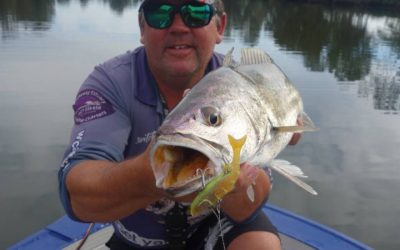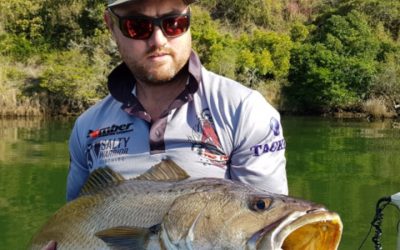The fishing at Forster – Tuncurry is superb, all year round with numerous options for land-based and boating anglers alike. Luke Austin has lived there all his life and shares some great spots for visiting anglers and locals alike.
Jewfish Fishing: Tips and Insights for Catching Southern Mulloway

If you’re an avid lure fisher in southern Australia, there’s a good chance that one day you’ll be bitten by the mulloway fishing bug. Southern mulloway, or “jewfish” are impressive fish that can be quite challenging to catch on lures. I’ve lost count of the number of lure fishers I’ve interviewed who found this species incredibly difficult to start with, but now consistently catch the “Ghost of the Estuary”.
So on this page you’ll find some valuable tips and insights from people who catch a lot of mulloway on lures. And at the bottom of the page you’ll find links to all of the ALF interviews that cover the topic of jewfish fishing.
Understanding the Southern Mulloway (Jewfish)
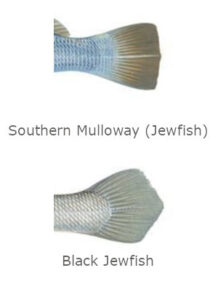
Jewfish can grow to impressive sizes, reaching lengths of up to 2 meters and weighing over 100 kilograms. However, the average size typically ranges between 80 and 120 centimeters. Southern Mulloway have a slender, elongated body with a silvery coloration and a distinct dark spot near their gills called an opercular spot. Their appearance may vary depending on factors such as age, habitat, and feeding habits.
Habitat and Feeding Behavior
Southern mulloway primarily inhabit estuaries, rivers, and coastal areas with sandy or muddy bottoms. They are often found near structures such as rock bars, bridges, jetties, and other submerged features. These fish are known to move between freshwater and saltwater environments, particularly during spawning periods. In estuaries, they can be located in deep holes, channels, and along drop-offs where they feed on a variety of prey, including fish, crustaceans, and other invertebrates.
Quick Tips for Mulloway Fishing Success
Times and tides for mulloway fishing:
Focus your fishing efforts during low light periods such as dawn and dusk when mulloway tend to be more active and responsive to lures. Additionally, fishing either side of tide changes, especially when there is a strong flow, can increase your chances of success. Tidal flow tends to concentrate bait around structure and eddies, so jewfish come to these areas to hunt. Often the high flow rates in the middle of the tide are too strong for fishing lures, but the slower flows near the turn of the tide are perfect. In many cases the bite can go quiet on the tide change when there’s not much water movement.
Mulloway Lures
Soft plastics and hard-body lures are the popular lure choices for mulloway fishing, though exact details vary depending on whether you’ll be fishing rocks, seawalls, estuaries and so on. Soft plastics that imitate baitfish, such as paddle-tail and curl-tail designs, rigged on a suitable jig head are great in natural colors like silver, white, and translucent shades. Consider using suspending or slow-sinking minnow-style hard-body lures that mimic injured or distressed fish. Diving depths of 1 to 3 meters are suitable for mulloway fishing even in deeper water at the ends of seawalls. Soft vibes are also popular and effective jewfish lures in the 90-100mm size range.
Experiment with different retrieve speeds, pauses, and variations to determine what triggers a strike. A slow and steady retrieve with occasional pauses can be very effective when fishing large hard body lures. Gentle lifts and hops can work very well with soft plastics and vibes. It’s worth checking out the interviews and show notes for ALF episodes that feature jewfish for lure and location specific advice.
Mulloway Fishing Tackle Selection
Mulloway are relatively clean fighters, so in areas where there are no hard structures to accidentally foul they can often be played out on very light gear. On the other hand, the tackle for fishing from ocean rocks and seawalls often needs be very heavy in order to cope with bigger fish and tough conditions. You can download our mulloway lures and tackle cheat sheet from this page. One thing that is common to all combos is the need for a quality reel equipped with a smooth drag system to handle the strong runs and bursts of these fish.
Mulloway Fishing Locations
Mulloway often congregate in deep holes, channel edges, drop-offs, and structure-rich areas like rock bars, bridge pylons, and jetties. However, they may not always be feeding in these areas and often come into the surf zone, headlands, eddies and shallow water to hunt. Estuary know that the fish distribute through an entire river system during the drier months when the salt water pushes up. But the prime mulloway fishing times are often after a big rain event, when fish congregate at the river mouths and feed madly on baitfish that are washed down. This is also a prime time to fish the foamy water at the end of seawalls. When fishing with lures at night the area beneath bridge lights is great place to find feeding mulloway.
Conservation and Ethical Fishing
Before going jewfish fishing, please familiarise yourself with relevant fishing regulations, catch limits, and size restrictions. Southern mulloway are particularly vulnerable to overfishing, and in many areas there are distinct signs that fish numbers and sizes are in decline. Practice ethical fishing and conservation by releasing undersized fish, handling caught fish with care, and respecting the environment.
ALF Episodes About Mulloway Fishing
The ALF episodes below either focus 100% on how to catch mulloway using lures, or they have a significant component about targeting mulloway.
- Lure fishing for mulloway is one of the most challenging sportfishing opportunities for southern anglers. It’s a species that takes some dedication and commitment to crack, but it’s also a very rewarding fish to catch.
- Mulloway fishing isn’t just an after dark pursuit. Nearly all of my ALF podcast guests catch the majority of their fish during daylight hours.
- The majority of lure caught mulloway are taken in estuary systems, but targeting them in bays, or land-based from seawalls or ocean rocks is also effective.
- Many top anglers have noted that once active mulloway are located they are usually not fussy about what lure you put in front of them.
- Tides can be important. Mulloway fishing can be productive on most tides, but where, and how, you fish for them may vary.
- The southern mulloway is found from around Canarvon in Western Australia around the south of the country and up the east coast as far as the Mary River.
- Mulloway are slow growing, maturing at around 5-6 years and living up to 40 years. For this reason, most lure fishing for mulloway is catch and release.
- They’re opportunistic predators and feed on a variety of prey including fish, crustaceans, and cephalopods. Their love of squid, sandworms and prawns is legendary.
- Those who have done a bit of mulloway fishing will have heard the croaking sound they make whilst being handled. They make this by grinding their pharyngeal teeth together.
- Mulloway have an eye adaptation called the Tapetum Lucidum, which gives them better vision than most fish when the light is dim or the water is murky.
- Hard bodied diving lures are particularly effective when mulloway fishing from rock walls when rivers are in flood
- Soft plastic jerkbaits and paddletails can be deadly in most environments, with larger lures used on seawalls and rock ledges and smaller ones more typically used in bays and estuaries.
- Soft prawns are effective in a range of environments, but particularly when jewfish fishing estuaries around new moons when natural prawns are active.
- Soft Vibes are consistently effective, especially in deeper water or where there is more current flow.
- Metal blades, jointed swimbaits and metal slow pitch jigs are also effective mulloway lures at times.
Matt Poulos’ Georges River Fishing Secrets: Jewfish On Lures
This interview about...
The Five Best Fishing Spots In Sydney With Luke Kay
The greater Sydney area has no shortage of fishing opportunities for lure tossers, as today’s guest Luke Kay shares in this interview. From the bays and estuaries to the ocean rocks, Luke takes us through where he likes to go in search of fish.
Secrets To Lure Fishing In Lake Macquarie During Winter
EPISODE 630 Lake...
Episode 613: Ballina Headlands Jewfish With Tristan Sloan
Tristan Sloan grew up chasing jewfish from the rock walls and headlands of the Ballina area and now has returned to his old stomping grounds to continue his success at luring jewfish.
Episode 575: Jewfish Roundup With Greg Vinall
Greg has hosted the...
Episode 569: Lake Macquarie On Lures With Dan Guilfoyle. Part 1: Summer.
Lake Macquarie might cop a lot of fishing pressure over the summer months, but that doesn’t mean there aren’t some great opportunities on offer for those in the know about how, when and where to fish! Dan Guilfoyle shares a lifetime of local knowledge for those keen to hit the water in the coming months.
Episode 566: Sydney Jewfish With Joey And Shroom
“Joey The Jewy King” has a reputation throughout Sydney forhis ability to nail plenty of quality jewies on lures during the hours of darkness.
Episode 549: Northern NSW Land-Based Jewfish With Josh Annand
The NSW Northern coastline is a superb destination for a great many prized fishing species, but few are so revered as the jewfish. Definitely one the country’s more challenging fish species on lures, it’s understandable that many keen jewfish anglers guard their knowledge closely. Today’s guest Josh Annand isn’t one of those though. He came onboard the ALF podcast to share what he’s learned about targeting jewfish on lures from the stones – and he didn’t hold back.
Discover the Best Fishing Spots in Southeast Queensland this Spring
For the boating angler, Southeast Queensland during spring is all about big snapper, quality jewfish, threadfin salmon, flathead and plenty more! Nabeel Issa is a multiple time ALF podcast guest and always has plenty of great info to share. Today he walks us through why spring is his favourite time to fish in SEQ and gives us the rundown on how, when and where.
Episode 532: Top Brisbane Landbased Fishing Spots In Winter With Beau Rixon
Brisbane offers an astonishing range of land based fishing options to suit anglers of all skill levels, ranging from the hunble flathead right through to tailor, squid, bass and jewfish. Local fishing tutor and land-based guide Beau Rixon spends a lot of time fishing the area from the shore and teaching others to do the same, so for today’s episode I invited Bea to jump onboard and share some of his favourite land based spots.
Episode 527: Best Botany Bay Winter Fishing Spots With Gary Brown
Botany Bay is an incredibly productive system and in the winter months the crowds thin out and the fishing goes off! Gary Brown has written numerous books and articles on fishing Botany Bay and in today’s ALF episode he shares his favourite winter fishing spots.
Massive Sydney Harbour Jewfish With George Anasta
Targeting jewfish in Sydney Harbour can be productive, but requires knowledge and persistence. George Anasta shares his experience with ALF listeners in this interview.
Episode 462: Northern NSW Land Based Jewfish With Cameron Harlen-Roberston
Cameron Harlen-Robertson is only a young man, but he’s been consistently catching land based jewfish that would satisfy the most seasoned veteran!
Episode 459: Patterson River Mulloway With Casey George
Casey George has been fishing the Patterson River at least weekly for four years or so and has developed good consistency on the mulloway in this system
Episode 411: Richmond River Jewfish With John Oatley
The Richmond River system holds quality jewfish – and Ballina lure fishing tragic John Oatley has a fair idea how to catch them!
Episode 410: Hunter River Jewfish With JJ Edwards
Casting handmade swimbaits at jewfish feeding under lights? That’s a special experience that todays guest JJ Edwards shares in episode 410.
Episode 402: Lake Macquarie Jewfish With Garret Windeatt
Lake Macquarie has good populations of jewfish despite the fishing pressure it endures. Garret Windeatt consistently gets amongst them and explains how in this interview.
Mysterious Hawkesbury Tributary Jewfish With Aaron Papas
Aaron Papas brings a fresh new perspective with plenty of insights to the Hawesbury Jewfish challenge!
Hawkesbury River Jewfish Tips With Kevin Savvas
The Hawkesbury River system is a popular and productive jewfish spot that Kev Savvas has been fishing for decades. Some awesome tips shared in this episode!
Episode 337: Coorong Topwater Mulloway With Scotty Tarasenko
Mulloway fishing isn’t always about finding deep holes and bouncing bottom lures. Scotty Tarasenko consistently catches quality fish using surface lures over shallow flats.
INSANE Sydney Harbour Jewfish With Cam Cronin
Cam Cronin is an obsessed Sydney jewfish on lures enthusiast, sponsored angler and walking jewfish encyclopaedia.
Episode 307: Glenelg River Mulloway With Dan Mackrell
Dan Mackrell Sponsored...
Episode 304: Lake Macquarie Jewfish With Dan Guilfoyle
Lake Macquarie might be in close proximity to some pretty decent human populations, but it holds some quality jewfish, despite the fishing pressure, as Dan Guilfoyle explains!
Episode 258: NSW Central Coast Jewfish With Leon Gaston
Leon Gaston has done pretty well on NSW Central Coast jewfish and in Episode 258 of the Podcast he shares his tips for others interested in doing the same thing!
Episode 224: Newcastle Harbour Jewfish With Jesse Dedman
Despite its proximity to large populations, Newcastle Harbour holds good numbers of quality jewfish. In ALF Episode 224 local jewfish enthusiast Jesse Dedman shares his tips and tricks for targeting this tricky species on lures.
Episode 209: Lake Macquarie Jewfish With Mark Williams
In the decade since the banning of commercial netting in Lake Macquarie, the jewfish fishery has jumped to new levels. Local guru Mark Williams shares his tips for targeting jewfish in Episode 209.
Episode 152: St Georges Basin Jewfish With Dave Johnstone
Over the past 5 years fishing for jewfish in St Georges Basin has become very worthwhile, with the quality and quantity of fish increasing since netting ceased. Dave Johnstone is well know for his Basin fishing exploits and has put a lot of hours into figuring the jewfish out.
Episode 137: Mid North NSW Coast Jewfish With Karl Attenborough
Sand Flat Fishing Australia’s Karl Attenborough puts us in touch with NSW mid-north coast jewfish on lures in this exciting episode of the Australian Lure Fishing podcast.
Secrets Of Brisbane River Jewfish With Peter Herbst
Brisbane River jewfish on lures? In this episode Brisbane local gun Peter Herbst shares his tips and tricks for making it happen!
Moreton Bay Ghosts: Lure Fishing for Jewfish On Brissie’s Doorstep
In this episode Nabeel Issa explains his strategies for finding and catching Moreton Bay jewfish. You’ll be surprised just how prevalent this species is in the bay, and Nabeel will arm you with the knowledge you’ll need to successfully target them.
Secrets Of Sydney Daylight Jewfish With Chris Cleaver
Catching quality jewfish during the day in the highly pressured waters around Australia’s largest population centre has become an art for respected jewie specialist Chris Cleaver. In this episode Chris shares his secrets and dispels the misconceptions around finding and catching jewfish on lures.
Hawkesbury Fishing: Ultimate Guide To Jewfish With Dan Selby
The Hawkesbury River system is large and holds plenty of jewfish for those who know how to chase them. In this episode of ALF, Dan Selby downloads his tips for getting amongst the jewfish action!
Episode 82: Northern NSW and SEQ Estuary Jewfish with Brad Smith
Brad “Smithy” Smith is a long-time Gold Coast fishing guide with 25 years experience targeting jewfish on lures in the estuaries of northern NSW and southern Queensland. In this episode Smithy share two little know but deadly techniques he’s developed for targeting this awesome sport fish.
Episode 78: Hastings River Jewfish With Mark Saxon
Mark Saxon is a gun estuary fishing guide in Northern New South Wales and the developer of Sax Scents. Mark has the local jewfish population well worked out. In this episode Mark shares his tips for bagging a decent Hastings River jewfish or two.
Episode 76: Manning River Jewfish With Adam Maddalena
The Manning River system is a productive jewfish destination. Local angler, jewie specialists and Youtuber Adam Maddalena explains his strategies for tangling with a few of these elusive fish.
Episode 51: NSW South Coast Jewfish With Steve Starling
Mulloway (Jewfish) are, as Starlo explains, a cryptic species. Few fishermen have them so wired that they can consistently catch this species on lures. Starlo is one who has worked hard at figuring mulloway out – and in this episode he explains the tips and tricks that have vastly improved his success on south coast mullys.
Episode 46: Coffs Harbour Headland Jewfish With Shea Cooper
Jewfish can be successfully targeted year-round from the rocks and headlands around Coffs Harbour. Local jewie specialist Shea Cooper explains the tackle, lures and techniques he uses to consistently catch this awesome sports fish.
Episode 38: Glenelg River Mulloway With Mark Gercovich
The Glenelg River system offer superb lure fishing for mulloway, as renowned Victorian angler and journalist Mark Gerkovich explains. You’ll love his advice on the lures to use, too!
Yamba Fishing: Shore-based Jewfish Fishing With Mick Leavey
Jewfish (mulloway) are one of the more challenging targets for southern estuary lure fishers. In this episode Mick Leavey from Yamba explains how to go about catching this enigmatic species.




